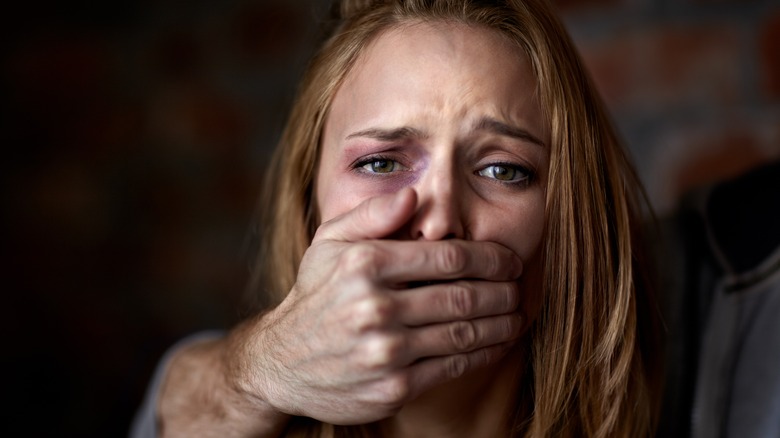Crime Analyst's Laura Richards Tells Us The No. 1 Sign Someone Is A Victim Of Coercive Control
Just over a year ago, the world was captivated by the disappearance and murder of Gabby Petito. Only 22 at the time, Petito was reported missing when her fiancé, Brian Laundrie, returned to his home state of Florida claiming not to know what happened to her (via CBS News). While the case is considered closed, experts believe there were clear signs of domestic abuse that went unnoticed by law enforcement.
About a month before Petito was reported missing, a witness called 911 reporting seeing, "a male hit a female," resulting in the couple being pulled over by the Moab Police Department, per Fox 13 News. According to the transcript and body cam footage obtained by criminal behavioral analyst Laura Richards, Petito is told by a responding police officer that two separate witnesses saw Laundrie hit her (via "Crime Analyst"). But Petito downplays Laundrie's actions, taking the blame instead.
A newly released 99-page independent review done by the City of Moab agrees with Gabby: not only did they believe she was the main aggressor but they believed Petito should have been cited for domestic violence. Confusingly, the review also found that she was "likely" the victim of long-term domestic abuse herself.
To better understand how the independent review could have concluded that Petito was a potential victim, we turned to Richards — whose podcast, "Crime Analyst," just wrapped up a twenty-episode series on Petito's case — for her insight.
Why emotional abuse is so hard to spot
Domestic abuse is often only taken seriously after it's too late to save a life. In the case of Gabby Petito, experts believe the Moab Police Department had an opportunity to prevent her murder if the officers had been properly trained to spot signs of coercive control, a dangerous form of emotional abuse.
Dr. Ziv Cohen, a forensic psychiatrist with Cornell University, told People that Petito's behavior shown in the police body cam footage seemed "to fit the profile of a domestic abuse situation." Not only did she act "quite scared," Cohen believed she was trying to protect Laundrie.
When we asked Laura Richards, creator of the Domestic Abuse, Stalking and Honour Based Violence (DASH) Risk Assessment and Management Model, to expand on victim behavior, she explained in an email that often, victims "will apologize, take responsibility for things even though they are not to blame." If a victim does ask for help, it can be easy to miss if you're not properly trained to pick up on the nuances of victim behavior. "They are likely to throw little lines out, like [Petito] did, hoping you follow up," Richards told us, adding that: "When you don't they know they cannot trust you to get it."
Unfortunately, as Richards points out in Episode 96 of her podcast, "Crime Analyst," both the responding officers and subsequent independent review done by the City of Moab missed the signs Petito needed help.
Victims often protect their abusers
When Gabby Petito is separated from Brian Laundrie by police officers during the traffic stop on August 12, 2021, she repeatedly takes the blame. According to psychologist Paige Carambio, PsyD, the type of repetitive apologizing is actually a "self-preservation technique" victims will use to protect themselves from their abuser (via DomesticShelters.org).
In Episode 80 of her podcast, "Crime Analyst," Richards highlights that when Officer Pratt talks to Petito, he tells her two separate witnesses said they'd seen Laundrie "punch" her. "Well to be honest," Petito tells the officers in the body cam footage, "I definitely hit him first."
Officer Pratt continues to question Petito about the altercation and eventually she does admit to Laundrie grabbing her face, before quickly reminding Pratt she hit Laundrie first. For Richards, this behavior raises too many questions; why was Petito so hesitant to tell Pratt what really happened?
Richards stresses in Episode 80 of "Crime Analyst" that "hands around the neck and/or grabbing the face in this way are a high risk factor to serious harm and femicide seven-fold." She adds that, in her experience, once an abuser escalates to non-fatal strangulation, behavior never de-escalates. In Laudrie's case, his behavior escalated to the point of the Teton County Coroner ruling Petito's death a homicide by strangulation, per CNN.
In Episode 96 of "Crime Analyst," Richards notes that neither the police on-scene that day nor the independent review done by the City of Moab follows up about Laudrie's violent behavior.
Other signs of domestic abuse the Moab Police Department missed
Unfortunately, those weren't the only signs of domestic abuse the Moab Police Department missed that day.
In the body cam footage released by the Moab Police Department, Laundrie is seen telling officers that the couple had been having a nice morning until it was time to head to the next spot on their trip. Launderie tells officers he'd even given Petito time to work on "her own little website-blog" earlier that morning. When the police officers ask about why Petito had scratches on her face, Laundrie explains that Petito was holding "the cell phone" and he was trying to "push her away" so she could take time to collect herself.
In Episode 80 of her podcast, "Crime Analyst," crime analyst Laura Richards explains that for her, this is not only an indicator of who holds the power in the relationship (he "gave" Petito time) but speaks volumes to what he feels about the work she's trying to do.
"A partner who reduces you, devalues you and what you love and shrinks your world, does not want the best for you," Richards told The List in an email. What the abuser is trying to do, she added, is control you completely. If you can diminish someone's self-worth, Sabina Mauro, PsyD, a licensed psychologist, told PsychCentral it's easier to keep victims "trapped in a cycle of feeling self-blame, guilt, shame" and that they "deserve" to be abused.
If you or someone you know is dealing with domestic abuse, you can call the National Domestic Violence Hotline at 1−800−799−7233. You can also find more information, resources, and support at their website.



